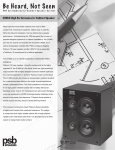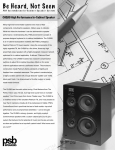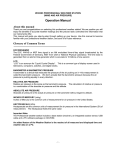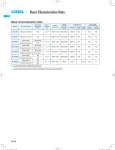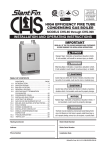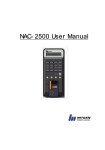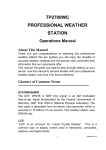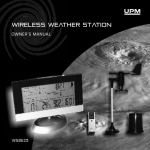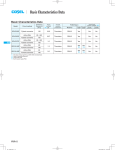Download Basic Characteristics Data
Transcript
Basic Characteristics Data Basic Characteristics Data Circuit method Switching frequency [kHz] Input current Rated input fuse Inrush current protection Material CHS60 Foward converter 440 *1 - - CHS80 Half-bridge converter 250 *1 - - CHS200 Full-bridge converter 150 *1 - CHS300 Full-bridge converter 170 *1 - CHS400 Full-bridge converter 150 *1 CHS500 Full-bridge converter 150 *1 Model *1 R efer to Specification. *2 R efer to Instruction Manual. CHS CHS-16 Series/Redundancy operation availability PCB/Pattern Single sided Double sided Series operation Redundancy operation glass fabric base, epoxy resin Multilayer Yes *2 glass fabric base, epoxy resin Multilayer Yes *2 - glass fabric base, epoxy resin Multilayer Yes *2 - glass fabric base, epoxy resin Multilayer Yes *2 - - glass fabric base, epoxy resin Multilayer Yes *2 - - glass fabric base, epoxy resin Multilayer Yes *2 DC-DC Converters Bus Converter.Power Module Type Instruction Manual 1 Pin Connection CHS-18 2 Connection for Standard Use CHS-18 3 Wiring Input/Output Pin CHS-19 4 5 6 3.1 Wiring input pin CHS-19 3.2 Wiring output pin CHS-19 Function CHS-19 4.1 Overcurrent protection CHS-19 4.2 Overvoltage protection CHS-20 4.3 Thermal protection CHS-20 4.4 Remote ON/OFF CHS-20 4.5 Remote sensing CHS-20 4.6 Adjustable voltage range CHS-21 4.7Isolation CHS-22 4.8 CHS-22 PMBus interface Series and Parallel Operation CHS-22 5.1 Series operation CHS-22 5.2 Parallel operation CHS-22 5.3 Redundancy operation CHS-22 Implementation-Mounting Method CHS-23 6.1 Mounting method CHS-23 6.2 Automatic Mounting (CHS series:option S) CHS-23 6.3 Soldering CHS-23 6.4 Stress onto the pins CHS-24 6.5Cleaning CHS-24 6.6 Storage method (CHS series:option S) CHS-24 6.7 Stress to the product CHS-24 7 Safety Considerations CHS-25 8 Derating CHS-25 8.1 9 CHS Derating SMD type(optionS) package information CHS-25 CHS-29 CHS-17 CHS DC-DC Converters Bus Converter . Power Module Type Table 1.1 Pin Connection and function 1 Pin Connection No. Pin Connection 1 +VIN 2 RC Remote ON/OFF 3 -VIN -DC input 4 +VOUT ¿CHS60 -VIN 3 RC 2 +VIN 1 8 -VOUT 7 -S 6 TRM 5 +S 4 +VOUT ¿CHS80 RC 2 +VIN 1 CHS 8 -VOUT 7 -S RC 2 6 TRM 5 +S 4 +VOUT +VIN 1 +S 6 TRM +DC output +Remote sensing Adjustment of output voltage -S 8 -VOUT No. Pin Connection 1 +VIN ¿CHS200 -VIN 3 5 Function +DC input 7 8 -VOUT 7 -S 6 TRM 5 +S 4 +VOUT -VIN 3 Instruction Manual -Remote sensing -DC output Reference 3.1 ”Wiring input pin ” 2 RC 4.4 ”Remote ON/OFF ” 3 -VIN 3.1 ”Wiring input pin ” 4 +VOUT 3.2 ”Wiring output pin ” 5 +S 4.5 ”Remote sensing ” 6 TRM 7 -S 4.5 ”Remote sensing ” 8 -VOUT 3.2 ”Wiring output pin ” 4.6 ”Adjustable voltage range ” 2 Connection for Standard Use ¡In order to use the power supply, it is necessary to wire as shown in Fig.2.1. ¿CHS300 -VIN 3 8 -VOUT 7 -S RC 2 6 TRM 5 +S 4 +VOUT +VIN 1 Reference : 3 ”Wiring Input/Output Pin” ¡Short the following pins to turn on the power supply. -VIN RC, +VOUT +S, -VOUT -S Reference : 4.4 ”Remote ON/OFF” ¿CHS400/CHS500 -VIN 3 8 -VOUT 7 -S RC 2 6 TRM 5 +S 4 +VOUT +VIN 1 8 ”Derating” 4.5 ”Remote sensing” ¡The CHS series handle only the DC input. Avoid applying AC input directly. It will damage the power supply. Fuse +VIN Cin + DC input RC -VIN +VOUT +S Load -S -VOUT Cin : External capacitor on the input side Fig.1.1 Pin Connection (bottom view) Fig.2.1 Connection for standard use Table 2.1 Recommended External capacitor on the input side Model CHS30024 Cin 660 F or more Model CHS6048 CHS-18 CHS8048 CHS20048 CHS30048/CHS40048/CHS50048 Cin 66 F or more 33 F or more 100 F or more 200 F or more DC-DC Converters Bus Converter . Power Module Type 3 Wiring Input/Output Pin In this case, please install a capacitor Co. wiring impedance. (1) External fuse ¡Fuse is not built-in on input side. In order to protect the unit, install the normal-blow type fuse on input side. ¡When the input voltage from a front end unit is supplied to multiple units, install the normal-blow type fuse in each unit. Table 3.1 Recommended fuse (Normal-blow type) Model CHS30024 Rated current 20A Model CHS6048 CHS8048 CHS20048/CHS30048 CHS40048 CHS50048 5A ¡If output current decreases rapidly, output voltage rises transiently and the overvoltage protection circuit may operate. ¡Select a high frequency type capacitor. Output ripple and startup waveform may be influenced by ESR-ESL of the capacitor and the 3.1 Wiring input pin Rated current Instruction Manual 7A 15A 20A 30A ¡Make sure that ripple current of Co is than its rating. Table 3.2 Recommended capacitance Co (CHS60, CHS80, CHS200) No. Output voltage CHS60 CHS80 CHS200 1 3.3V 0 - 20,000 F 0 - 20,000 F 0 - 40,000 F 2 5V 0 - 10,000 F 0 - 10,000 F 0 - 20,000 F 3 12V 0 - 2,200 F 0 - 1,000 F 0 - 2,200 F Table 3.3 Recommended capacitance Co (CHS300, CHS400, CHS500) No. Output voltage CHS300 CHS400/CHS500 (2) External capacitor on the input side 1 5V 0 - 20,000 F - ¡Install an external capacitor Cin, between +VIN and -VIN input pins for low line-noise and for stable operation of the power sup- 2 10V 0 - 2,200 F 0 - 4,000 F 3 12V 0 - 2,200 F 0 - 4,000 F 4 15V 0 - 2,200 F ply. Capacitance Refer to Table 2.1 Ta = -20 to +85C Electrolytic or Ceramic capacitor Ta = -40 to +85C Ceramic capacitor - ¡Ripple and Ripple Noise are measured, as shown in the Fig.3.3. Cin is shown in Table 2.1. 50mm ¡Cin is within 50mm for pins. Make sure that ripple current of Cin is less than its rating. (3) Recommendation for noise-filter ¡Install an external input filter as shown in Fig.3.1 in order to reduce conducted noise. Cin is shown in Table 2.1. Measuring board +VIN +VOUT DC Input Cin +S + RC -S Co 22 F Load -VIN -VOUT 1mH DC input +VIN + 2. 2 F Cin RC -VIN 0.068 F 0.068 F +VOUT +S -S -VOUT + 10 F 0.033 F Load Oscilloscope BW:100MHz 0.033 F C FG Fig.3.1 Recommended external input filter R 1.5m 50W Coaxial cable R=50W C=0.01 F Fig.3.3 Measuring method of Ripple and Ripple Noise (4) Reverse input voltage protection ¡Avoid the reverse polarity input voltage. It will damage the power supply. It is possible to protect the unit from the reverse input voltage by installing an external diode as shown in Fig.3.2. +VIN DC IN -VIN Fig.3.2 Reverse input voltage protection 3.2 Wiring output pin ¡When the CHS series supplies the pulse current for the pulse load, please install a capacitor Co between +VOUT and -VOUT pins. 4Function 4.1 Overcurrent protection ¡Over Current Protection (OCP) is built-in and works at 105% of the rated current or higher. However, use in an overcurrent situation must be avoided whenever possible. The output voltage of the power module will recover automatically when the fault causing overcurrent is corrected. When the output voltage drops after OCP works, the power module enters a ”hiccup mode” where it repeatedly turns on and off at a certain frequency. Recommended capacitance of Co is shown in Table 3.2, 3.3. CHS-19 CHS Instruction Manual DC-DC Converters Bus Converter . Power Module Type 4.2 Overvoltage protection ¡The overvoltage protection circuit is built-in. The DC input will be shut down if overvoltage protection is in operation. ¡When remote ON/OFF function is not used, please short between RC and -VIN (-R: open between RC and -VIN). Vcc (2.0[Vcc[7.0V) The output voltage of the power module will recover automatically RC when the fault causing over voltage is corrected. -VIN Remarks : -VIN Photo coupler Please note that devices inside the power supply might fail when voltage more than rated output voltage is applied to output pin of the power supply. This could happen when the customer tests the overvoltage performance of the unit. 4.3 Thermal protection Transistor RC RC -VIN -VIN IC ¡When the power supply temperature is kept above 120C, the thermal protection will be activated and simultaneously shut down the output. The output voltage of the power supply will recover automatically when the unit is cool down. Relay Fig.4.1 RC connection example 4.5 Remote sensing (1) When the remote sensing function is not in use +VOUT ¿-U +S -S -VOUT ¡Option ”-U” means output is shut down when the abovementioned protection circuit is activated. If this happens, protection circuit can be inactivated by cycling CHS RC ¡When the remote sensing function is not in use, it is necessary to confirm that pins are shorted between +S & +VOUT and between -S & -VOUT. 4.4 Remote ON/OFF ¡Remote ON/OFF circuit is built-in on the input side (RC). The ground pin of input side remote ON/OFF circuit is ”-VIN” pin. Table 4.1.1 Specification of Remote ON/OFF(CHS80,CHS200) ON/OFF logic Standard Negative Optional -R Positive Between RC and -VIN L level(0 - 0.8V) or short H level(2.0 - 7.0V) or open L level(0 - 0.8V) or short H level(2.0 - 7.0V) or open Output ¡Wire between +S & +VOUT and between -S & -VOUT as short as possible. Loop wiring should be avoided. This power supply might become unstable by the noise coming from poor wiring. (2)When the remote sensing function is in use Wire as close as possible voltage ON OFF OFF ON +VOUT +S -S -VOUT When RC is ”Low” level, fan out current is 0.1mA typ. When Vcc is applied, use 2.0[Vcc[7.0V. Table 4.1.2 Specification of Remote ON/OFF(CHS60,CHS300,CHS400,CHS500) ON/OFF logic Standard Negative Optional -R Positive Between RC and -VIN L level(0 - 0.8V) or short H level(4.0 - 7.0V) or open L level(0 - 0.8V) or short H level(4.0 - 7.0V) or open Output voltage ON OFF OFF ON When RC is ”Low” level, fan out current is 0.1mA typ. When Vcc is applied, use 4.0[Vcc[7.0V. Short at pin root Fig.4.2 Connection when the remote sensing is not in use the DC input power off for at least 1 second or toggling Remote ON/OFF signal. Load Load Fig.4.3 Connection when the remote sensing is in use ¡Twisted-pair wire or shield wire should be used for sensing wire. ¡Thick wire should be used for wiring between the power supply and a load. Line drop should be less than 0.3V. Voltage between +VOUT and -VOUT should remain within the output voltage adjustment range. ¡If the sensing patterns are short, heavy-current is drawn and the pattern may be damaged. The pattern disconnection can be prevented by installing the protection parts as close as possible to a load. ¡Output voltage might become unstable because of impedance of wiring and load condition when length of wire exceeds 40cm. CHS-20 DC-DC Converters Bus Converter . Power Module Type 4.6 Adjustable voltage range Instruction Manual (2) To decrease output voltage (1) To adjust output voltage ¡Output voltage is adjustable by the external potentiometer. ¡When the output voltage adjustment is used, note that the over ¡By connecting the external resistor (RD), output voltage becomes adjustable to decrease. The external resistor (RD) is calculated by the following equation. voltage protection circuit operates when the output voltage is set RD= too high. ¡If the output voltage drops under the output voltage adjustment range, the Low voltage protection operates. ¡By connecting the external potentiometer (VR1) and resistors (R1, R2), output voltage becomes adjustable, as shown in Fig.4.4. Recommended external parts are shown in Table 4.2. Δ= 5.11 Δ -10.22 [kW] VOR-VOD VOR VOR : Rated output voltage [V] VOD : Output voltage needed to set up [V] ¡The wiring to the potentiometer should be as short as possible. The temperature coefficient could become worse, depending on +VOUT +S the type of a resistor and potentiometer. Following parts are recommended for the power supply. Resistor.............Metal film type, coefficient of less than ±100ppm/C Potentiometer....Cermet type, coefficient of less than ±300ppm/C TRM RD ¡When the output voltage adjustment is not used, open the TRM pin respectively. -S -VOUT ¡The change speed of the TRM voltage should be less than 0.15V/ ms, when changing output voltage to less than 90% of the rated. Fig.4.5 Connection to decrease output voltage +VOUT (3) To increase output voltage +S Control Amp. of rated voltage R1 RA 5.11kW 1.225V + TRM R2 RC 5.11kW ¡By connecting the external resistor (RU), output voltage becomes adjustable to increase. The external resistor (RU) is calculated by the following equation. VR1 5kW RU= Δ= -S -VOUT Fig.4.4 Output voltage control circuit Table 4.2 Recommended value of external potentiometer & resistor Output adjustable range No. VOUT VOUT ±5% R1 R2 5.11XVORX(1+Δ) 1.225XΔ R1 R2 1 3.3V 2.2kW 68kW 2.2kW 33kW 2 5V 4.7kW 68kW 5.6kW 33kW 3 10V 15kW 68kW 15kW 33kW 4 12V 18kW 68kW 18kW 33kW 5 15V 22kW 68kW 22kW 33kW 5kW VR1 5kW 5.11 Δ - 10.22 [kW] VOU-VOR VOR VOR : Rated output voltage [V] VOU : Output voltage needed to set up [V] +VOUT +S RU VOUT ±10% VR1 - TRM -S -VOUT Fig.4.6 Connection to increase output voltage CHS-21 CHS DC-DC Converters Bus Converter . Power Module Type (4) Input voltage derating 115 the time of the use with this option. 12V 110 ¡As variance of output current drew from each power supply is maximum 10%, the total output current must not exceed the value 15V 105 100 determined by the following equation. 80 0 0 18 (Output current in parallel operation) 36 20 21.5 INPUT VOLTAGE [V] =(the rated current per unit) x (number of unit) x0.9 When the number of units in parallel operation increases, input 5V 120 3.3V 115 12V 110 105 100 95 3.3V,5V 90 12V 80 0 36 40 76 INPUT VOLTAGE [V] CHS6048 ADJUSTMENT RANGE [%] ADJUSTMENT RANGE [%] CHS30024 0 5V 120 3.3V 115 10V,12V 110 105 100 95 put circuitry is required, such as circuit pattern, wiring and current capacity for equipment. and load, and line drop should be less than 0.3V. 90 80 0 current increase at the same time. Adequate wiring design for in- ¡Total number of units should be no more than 3 pieces. ¡Thick wire should be used for wiring between the power supply 4812H 0 36 40 44 INPUT VOLTAGE [V] 76 CHS8048/CHS20048/CHS30048/ CHS40048/CHS50048 Fig.4.7 CHS Output Voltage Adjustment Range ¡Connect each input pin for the lowest possible impedance. ¡When the number of the units in parallel operation increases, inputcurrent increases. Adequate wiring design for input circuitry such as circuit pattern, wiring and current for equipment is required. DC INPUT 4.7 Isolation Fuse ¡For a receiving inspection, such as Hi-Pot test, gradually increase (decrease) the voltage to start (shut down). Avoid using Hi-Pot Fuse higher than the applied voltage at ON/OFF of a timer. 4.8 PMBus interface RC +Vin +Vout -Vin -Vout ¡Parallel operation is not possible. ¡Redundancy operation is available by wiring as shown below. Power + Supply - 5.1 Series operation ¡Series operation is available by connecting the outputs of two or more power supplies, as shown below. Output current in series connection should be lower than the lowest rated current in each Power + Supply - Load Power + Supply - I1 I3 I2 Fig.5.3 Redundancy operation ¡Even a slight difference in output voltage can affect the balance between the values of I1 and I2. Power + Supply - Load (b) Fig.5.1 Examples of series operation CHS-22 -Vout 5.3 Redundancy operation 5 Series and Parallel Operation Power + Supply - -Vin Fig.5.2 Examples of parallel operation ¡This option is equipped with a digital PMBus interface. Please contact us about for details. Power + Supply - +Vout RC ¿-I (CHS300/CHS400) unit. (a) +Vin LOAD SW tester with timer because it may generate voltage a few times Load CHS ¿-P (CHS400/CHS500) ¡This option is for parallel operation. ¡Sensing and adjustment of the output voltage are not possible at 5V 120 5.2 Parallel operation Load ADJUSTMENT RANGE [%] ¡When input voltage is 18-21.5V DC or 36-44VDC, the output voltage adjustment range becomes as shown in Fig.4.7. Instruction Manual Please make sure that the value of I3 does not exceed the rated current of the power supply. I3[the rated current value DC-DC Converters Bus Converter . Power Module Type 6 Implementation-Mounting Method Instruction Manual 48 1.5 +VIN 6.1 Mounting method ¡The unit can be mounted in any direction. When two or more power supplies are used side by side, position them with proper inter- RC vals to allow enough air ventilation. The temperature around each -VIN +VOUT +S TRM -S -VOUT power supply should not exceed the temperature range shown in (d) CHS300 derating curve. ¡Avoid placing the DC input line pattern layout underneath the unit. It will increase the line conducted noise. Make sure to leave an 8 41 ample distance between the line pattern layout and the unit. Also avoid placing the DC output line pattern underneath the unit because it may increase the output noise. Lay out the pattern away from the unit. ¡Avoid placing the signal line pattern layout underneath the unit because the power supply might become unstable. Lay out the pattern away from the unit. ¡Avoid placing pattern layout in hatched area shown in Fig.6.1 to insulate between pattern and power supply. 7 +VIN +VOUT +S TRM -S -VOUT RC -VIN (e) CHS400 5 Dimensions in mm +VOUT +S TRM -S -VOUT RC 13 1 +VIN -VIN 2 6.2 Automatic Mounting (CHS series:option S) ¡To mount CHS series automatically, use the inductor area near the output pin as an adsorption point. Please see the External View 10 for details of the adsorption point. (a) CHS60 5 If the bottom dead point of a suction nozzle is too low when mounting excessive force is applied to the inductor, it could cause 14 damage. Please mount carefully. +VIN +VOUT +S TRM -S -VOUT RC -VIN 6.3 Soldering (1)Flow Soldering :260C (2)Soldering Iron (b) CHS80 37 5 CHS Fig.6.1 Prohibition area of pattern layout (top view) 15 seconds or less :maximum 450C 5 seconds or less (3)Reflow Soldering (option “-S”) ¡Fig.6.2 shows conditions for the reflow soldering for option “-S” of CHS series. Please make sure that the temperatures of pin 8 24 terminals +VIN and -VOUT shown in Fig.6.2 do not exceed the +VIN +VOUT +S TRM -S -VOUT RC -VIN temperatures shown in Fig.6.3. ¡If time or temperature of the reflow soldering goes beyond the conditions, reliability of internal components may be compromised. Please use the unit under the recommended reflow conditions. (c) CHS200 CHS-23 Instruction Manual DC-DC Converters Bus Converter . Power Module Type 6.4 Stress to the pins +VIN -VOUT ¡When too much stress is applied to the pins of the power supply, the internal connection may be weakened. As shown in Fig.6.4, avoid applying stress of more than 19.6N (2kgf) to the pins horizontally and more than 39.2N (4kgf) verti- (a) CHS60 cally. ¡The pins are soldered on PWB internally. Therefore, do not pull or bend them with strong force. +VIN -VOUT ¡Fix the unit on PCB (using silicone rubber or fixing fittings) to reduce the stress to the pins. (b) CHS80 Fig.6.2 Temperature Measuring Points when Setting Less than 19.6N Reflow Soldering Conditions C Less than 19.6N Less than 19.6N Less than 39.2N Less than 39.2N Tp Less than 19.6N (option S) Tx Fig.6.4 Stress to the pins Ty2 6.5 Cleaning Ty1 ¡When cleaning is necessary, clean under the following conditions. Method : Varnishing, ultrasonic wave and vapor CHS A A’ B B' C time(s) A A' 1.0 - 5.0C/s Ty1:160±10C Ty2:180±10C B B' Ty1 - Ty2:120s max 1.0 - 5.0C/s Tp:Max245C 10s max C Tx:220C or more:70s max 1.0 - 5.0C/s Fig.6.3 Recommend Reflow Soldering Conditions ¿Notes to use option “-S” ¡Solder iron or other similar methods are not recommended soldering method for option “-S” because it may not be able to retain connection reliability between the PCB and the Pins. Solder reflow is the acceptable mounting system for the option. ¡Option “-S” is not reusable product after soldered on any application PCB. Cleaning agents : IPA (Solvent type) Total time : 2 minutes or less ¡Do not apply pressure to the lead and name plate with a brush or scratch it during the cleaning. ¡After cleaning, dry them enough. 6.6 Storage method (CHS series:option S) ¡To stock unpacked products in your inventory, it is recommended to keep them under controlled condition, 5-30C, 60%RH and use them within a year. ¡24-hour baking is recommended at 125C, if unpacked products were kept under uncontrolled condition, which is 30C, 60%RH or higher. Original trays are not heat-resistant. Please move them to heatresistant trays in preparation to bake. To check moisture condition in the pack. Silica gel packet has some moisture condition indicator particles. Indicated blue means good. Pink means alarm to bake it. ¡Notification. The tray will be deformed and the power supply might be damaged, if the vacuum pressure is too much to reseal. 6.7 Stress to the product ¡CHS series transformer core and choke coil core are attached by glue. There is a possibility that the core will be removed and power supply will be damaged when they receive stress by the fall or some kind of stress. CHS-24 DC-DC Converters Bus Converter . Power Module Type Instruction Manual 7 Safety Considerations ¡To apply for safety standard approval using this power supply, the following conditions must be met. ¿This unit must be used as a component of the end-use equipment. ¿The equipment must contain basic insulation between input and output. If double or reinforced insulation is required, it has to be Temperature measurement location Fig.8.2.2 Temperature measurement location (CHS80) provided by the end-use equipment in accordance with the final build-in condition. ¿Safety approved fuse must be externally installed on input side. 8Derating Temperature measurement location ¡It is necessary to note thermal fatigue life by power cycle. Please reduce the temperature fluctuation range as much as pos- Fig.8.2.3 Temperature measurement location (CHS200) sible when the up and down of temperature are frequently generated. 8.1 CHS Derating ¡Use with the convection cooling or the forced air cooling. Make sure the temperatures at temperature measurement locations shown from Fig.8.2.1 to Fig.8.2.8 below are on or under the derating curve in Fig.8.1. CHS Temperature measurement location Fig.8.2.4 Temperature measurement location (CHS300) Ambient temperature must be kept at 85C or under. 100 3 Load factor[%] 80 1Option “B” 2Option “BC” 3Others 60 2 1 40 Temperature measurement location 20 0 -40 Fig.8.2.5 Temperature measurement location (CHS400) -20 0 20 40 60 80 100 (95) Temperature of measurement location[C] 120 Fig.8.1 Derating curve Temperature measurement location Temperature measurement location Fig.8.2.6 Temperature measurement location (CHS500) Fig.8.2.1 Temperature measurement location (CHS60) CHS-25 DC-DC Converters Bus Converter . Power Module Type Instruction Manual 20 ¡For option “B” which is used with the convection cooling, forced air cooling or conduction cooling, use the temperature measure- 3 18 2 16 Load current[A] ment location as shown in Fig.8.2.7 and Fig.8.2.8. 12 10 8 6 4 Aluminum base plate 1 14 1convection cooling(0.2m/s) 21m/s 32m/s 2 0 -40 Measurement point -30 -20 -10 0 10 20 30 40 50 60 70 80 Fig.8.2.7 Measurement point (CHS200/CHS300 option “B” and “BC”) Fig.8.4 Load current vs. ambient temperature(CHS60483R3 Vin=48V) 14 2 3 Load current[A] 12 Aluminum base plate Measurement point 1 10 8 6 4 1convection cooling(0.2m/s) 21m/s 32m/s 2 Fig.8.2.8 Measurement point (CHS400/CHS500 option “B”) CHS ¡Shown the thermal curve with measuring as shown in Fig.8.3. Verify final design by actual temperature measurement. Use the temperature measurement location as shown in Fig.8.2.1 0 -40 -30 -20 -10 0 10 20 30 40 50 60 70 80 Fig.8.5 Load current vs. ambient temperature(CHS604805 Vin=48V) 7 3 6 Output side CHS 2 5 1 4 3 2 1convection cooling(0.2m/s) 21m/s 32m/s 1 Measurement point for ambient temperature and airflow 12.7mm 76mm Input side CHS Load current[A] PWB 25.4mm 90 Ambient temperature[C] to Fig.8.2.6 at 120C or less. Top 90 Ambient temperature[C] 0 -40 -30 -20 -10 0 10 20 30 40 50 60 70 80 90 Ambient temperature[C] Fig.8.6 Load current vs. ambient temperature(CHS604812 Vin=48V) 30 Airflow Airflow Fig.8.3 Measuring method Load current[A] 25 15 10 3 1 20 2 1convection cooling(0.2m/s) 21m/s 32m/s 5 0 -40 -30 -20 -10 0 10 20 30 40 50 60 70 80 90 Ambient temperature[C] Fig.8.7 Load current vs. ambient temperature(CHS80483R3 Vin=48V) CHS-26 DC-DC Converters Bus Converter . Power Module Type 18 18 16 12 10 8 1convection cooling(0.2m/s) 21m/s 32m/s 6 4 3 14 2 Load current[A] Load current[A] 16 3 1 14 10 8 1convection cooling(0.2m/s) 21m/s 32m/s 6 2 -30 -20 -10 0 10 20 30 40 50 60 70 80 0 -40 90 -30 -20 -10 0 Fig.8.8 Load current vs. ambient temperature(CHS804805 Vin=48V) Load current[A] Load current[A] 1convection cooling(0.2m/s) 21m/s 32m/s -30 -20 -10 0 10 20 30 40 50 Ambient temperature[C] 60 70 80 80 90 25 20 15 0 -40 90 1convection cooling(0.2m/s) 21m/s 32m/s -30 -20 -10 0 10 20 30 40 50 60 70 80 90 Ambient temperature[C] Fig.8.13 Load current vs. ambient temperature(CHS3002405 Vin=24V) 18 60 16 50 1 40 14 3 2 Load current[A] Load current[A] 70 5 Fig.8.9 Load current vs. ambient temperature(CHS804812 Vin=48V) 30 1convection cooling(0.2m/s) 21m/s 32m/s 20 10 -30 -20 -10 0 10 20 30 40 3 12 10 8 6 4 2 1 1convection cooling(0.2m/s) 21m/s 32m/s 2 50 60 70 80 0 -40 90 -30 -20 -10 Fig.8.10 Load current vs. ambient temperature(CHS200483R3 Vin=48V) 0 10 20 30 40 50 60 70 80 90 Ambient temperature[C] Ambient temperature[C] Fig.8.14 Load current vs. ambient temperature(CHS3002412 Vin=24V) 45 14 40 12 2 1 30 3 Load current[A] 35 Load current[A] 60 2 1 30 10 1 25 20 1convection cooling(0.2m/s) 21m/s 32m/s 15 10 -30 -20 -10 0 10 20 30 40 3 2 10 1 8 6 4 1convection cooling(0.2m/s)) 21m/s 32m/s 2 5 0 -40 50 3 35 2 5 0 -40 40 40 3 1 6 0 -40 30 45 7 2 20 Fig.8.12 Load current vs. ambient temperature(CHS2004812 Vin=48V) 8 3 10 Ambient temperature[C] Ambient temperature[C] 4 2 1 12 4 2 0 -40 Instruction Manual 50 60 70 80 90 Ambient temperature[C] Fig.8.11 Load current vs. ambient temperature(CHS2004805 Vin=48V) 0 -40 -30 -20 -10 0 10 20 30 40 50 60 70 80 90 Ambient temperature[C] Fig.8.15 Load current vs. ambient temperature(CHS3002415 Vin=24V) CHS-27 CHS DC-DC Converters Bus Converter . Power Module Type 32 35 28 2 1 20 Load current[A] Load current[A] 30 3 24 16 12 8 1convection cooling(0.2m/s) 21m/s 32m/s 1 20 15 10 1convection cooling(0.2m/s) 21m/s 32m/s -30 -20 -10 0 10 20 30 40 50 60 70 80 0 -40 90 -30 -20 -10 Fig.8.16 Load current vs. ambient temperature(CHS3004810 Vin=48V) Load current[A] Load current[A] 2 1 16 1convection cooling(0.2m/s) 21m/s 32m/s 4 -30 -20 -10 0 10 20 30 40 50 60 70 80 1 20 15 10 1convection cooling(0.2m/s) 21m/s 32m/s -30 -20 -10 Load current[A] Load current[A] 1 1convection cooling(0.2m/s) 21m/s 32m/s 20 30 40 50 60 70 80 90 20 15 -20 -10 0 10 20 30 40 50 60 70 80 90 40 3 2 30 1 25 1convection cooling(0.2m/s) 21m/s 32m/s 5 -30 -20 -10 0 10 20 30 40 50 1convection cooling(0.2m/s) 21m/s 32m/s -30 -20 -10 0 10 20 30 40 50 60 70 80 90 Ambient temperature[C] 45 35 0 -40 2 1 25 5 -30 3 30 10 Fig.8.18 Load current vs. ambient temperature(CHS3004812H Vin=48V) Load current[A] 10 35 Ambient temperature[C] 60 70 80 90 Ambient temperature[C] Fig.8.19 Load current vs. ambient temperature(CHS4004810 Vin=48V) CHS-28 0 Fig.8.21 Load current vs. ambient temperature(CHS4004812H Vin=48V) 2 4 0 -40 90 40 16 10 80 45 20 15 70 Ambient temperature[C] 3 24 20 60 2 25 0 -40 90 28 0 -40 50 5 Fig.8.17 Load current vs. ambient temperature(CHS3004812 Vin=48V) 8 40 3 Ambient temperature[C] 12 30 30 3 20 0 -40 20 35 24 CHS 10 Fig.8.20 Load current vs. ambient temperature(CHS4004812 Vin=48V) 28 8 0 Ambient temperature[C] Ambient temperature[C] 12 3 2 25 5 4 0 -40 Instruction Manual Fig.8.22 Load current vs. ambient temperature(CHS5004812 Vin=48V) DC-DC Converters Bus Converter . Power Module Type Instruction Manual 136 9 SMDtype(optionS)package information 38 23 38 48.55 34.1 ¡These are packed in a tray (Fig.9.1 to Fig.9.2). Please order “CHS60□□-S” or “CHS80□□-S” for tray type packaging. Capacity of the tray is 15max. In case of fractions, the units are stored in numerical order. 136 23 37 323 323 59×4=236 62X4=248 37 46.8 24.6 CHS Dimensions in mm Material : Conductive PS Fig.9.2 Delivery package information (CHS80) Dimensions in mm Material : Conductive PS Fig.9.1 Delivery package information (CHS60) CHS-29














